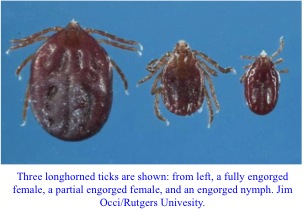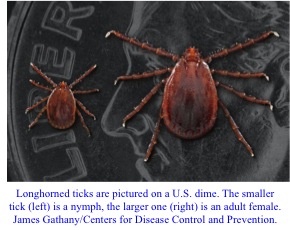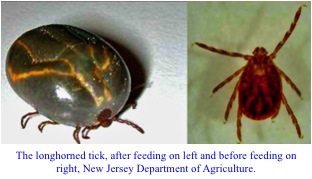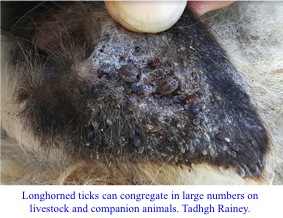The longhorned tick, Haemaphysalis longicornis, also known as Asian longhorned tick, cattle tick or bush tick, native to East Asia, is a recent invasive tick species in the United States. It is important to be on the lookout for this tick in
Arizona.
The first confirmed appearance of this tick species in the United States occurred on sheep in New Jersey during 2017. To date, the tick has been confirmed in 8 states, including Arkansas, Maryland, New Jersey, New York, North
Carolina, Pennsylvania, Virginia and West Virginia, and the suburbs of New York City. This tick species appears to be highly adaptive to a broad range of climates, from tropical to temperate, and utilizes an extremely broad range of host animals.
Within farms, it is found on cattle, horses, sheep, pigs, and poultry. Wild animals can support and move ticks across significant geographic ranges. The ticks have been found on bears, deer, foxes, opossum, raccoons, hares, rabbits, ferrets,
rats, and various birds. It has also been found on in-home pets including cats and dogs.

The longhorned tick is a three-host tick, meaning it requires three different hosts to complete its development through larval, nymph and adult life stages. The tick can reproduce sexually, or through an asexual process called parthenogenesis, meaning female ticks can reproduce without a male. The longhorned ticks found in the United States have all been parthenogenic. Therefore a single fed female tick can produce a whole population by herself.
Generally, female longhorned ticks lay eggs in late spring and early summer. After hatching from an egg, a larva seeks a host in late summer, consumes a blood meal, then drops off the host to overwinter. The following spring it molts into a nymph, which seeks a second host and feeds on blood, drops off a second time, and molts into an adult. An adult seeks a final host in mid-summer and feeds again. The adult female then drops off the host and lays up to 2,000 eggs over a period of 2-3 weeks.



The longhorned tick is an established livestock pest in New Zealand and Australia, known to transmit a parasite called Theileria annulata that causes theileriosis disease in cattle. Prominent symptoms in livestock include fever, anemia, weakness, abortion, difficulty breathing, increased heart rate, and lymph node enlargement. The tick has been associated with several other pathogens known to cause human illness. Disease causing pathogens have not yet been found in longhorned ticks in the United States. However, severe ectoparasitium of livestock in the United States has been documented, and feeding effects and blood loss can cause significant impacts on the health of livestock.
This new arrival is considered to be a great threat to livestock. The tick is an aggressive biter that frequently builds dense infestations on domestic hosts such as livestock. These infestations may cause great stress to animals, reduce livestock growth and production, and exsanguination, or serious blood loss.
Human disease causing pathogens such as Borrelia burgdorferi (Lyme spirochetes), spotted fever group rickettsiae, Ehrlichia chaffeensis, and Anaplasma bovis have been detected in longhorned tick populations in other countries. It has also been associated with Russian spring-summer encephalitis, Powassan virus, Khasan virus, tick-borne encephalitis virus, Japanese spotted fever, and severe fever with thrombocytopenia syndrome, although pathogens causing disease in humans have not so far been detected in the longhorned tick in the United States. At this moment, public health experts are concerned, but not alarmed.


If you suspect that you have found a longhorned tick, please collect a few ticks and send them for identification. Preferably, preserve the specimen in ethanol or rubbing alcohol (70% or greater is best) and gather information, including where the tick was collected, what host species it was collected from and the date of collection. Ship samples to the University of Arizona Insect Diagnostic Clinic https://cals.arizona.edu/ento/content/insect-id. For more information, contact lucyli@email.arizona.edu.
This material is based upon work that is supported in part by the National Institute of Food and Agriculture, U.S. Department of Agriculture (USDA NIFA) under the Crop Protection and Pest Management, Extension
Implementation Program, award number 2017-70006-27145 which provides Extension IPM funding to the University of Arizona. Any findings, recommendations, services, or organizations that are mentioned, shown, or indirectly implied in this publication
do not imply endorsement by the University of Arizona or the USDA. Any findings, recommendations, services, or organizations that are mentioned, shown, or indirectly implied in this publication do not imply endorsement by the University of Arizona
or the USDA.
Authors
Shujuan (Lucy) Li
Cooperative Extension - Arizona Pest Management Center, Maricopa Agricultural Center, University of Arizona
Dawn H. Gouge
Department of Entomology - College of Agriculture & Life Sciences, University of Arizona
Kathleen Walker
Department of Entomology - College of Agriculture & Life Sciences, University of Arizona
Alfred J. Fournier
Department of Entomology – College of Agriculture & Life Sciences, University of Arizona & Arizona Pest Management Center, University of Arizona
Contact:
Shujuan (Lucy) Li
lucyli@email.arizona.edu